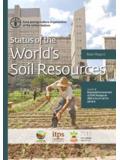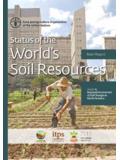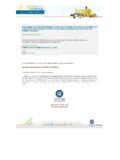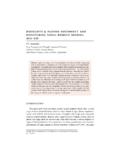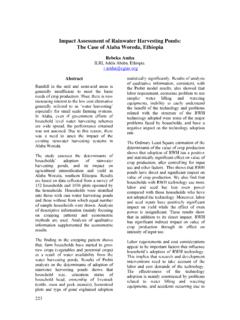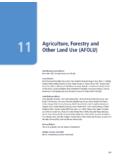Transcription of ACROLEIN - WHO | World Health Organization
1 This report contains the collective views of an international group of experts and does not necessarilyrepresent the decisions or the stated policy of the United Nations Environment Programme, theInternational Labour Organization , or the World Health International Chemical assessment Document 43 ACROLEINF irst draft prepared by R. Gomes and Meek, Existing Substances Division, Bureau of Chemical Hazards, HealthCanada, Ottawa, Canada, andM. Eggleton, Environment Canada, Hull, QuebecPlease note that the layout and pagination of this pdf file are not necessarilyidentical to those of the printed CICADP ublished under the joint sponsorship of the United Nations Environment Programme, the InternationalLabour Organization , and the World Health Organization , and produced within the framework of theInter- Organization Programme for the Sound Management of Health OrganizationGeneva, 2002 The International Programme on Chemical Safety (IPCS), established in 1980, is a joint ventureof the United Nations Environment Programme (UNEP), the International Labour Organization (ILO),and the World Health Organization (WHO).
2 The overall objectives of the IPCS are to establish thescientific basis for assessment of the risk to human Health and the environment from exposure tochemicals, through international peer review processes, as a prerequisite for the promotion of chemicalsafety, and to provide technical assistance in strengthening national capacities for the sound managementof Inter- Organization Programme for the Sound Management of Chemicals (IOMC) wasestablished in 1995 by UNEP, ILO, the Food and Agriculture Organization of the United Nations, WHO,the United Nations Industrial Development Organization , the United Nations Institute for Training andResearch, and the Organisation for Economic Co-operation and Development (Participating Organiza-tions), following recommendations made by the 1992 UN Conference on Environment and Developmentto strengthen cooperation and increase coordination in the field of chemical safety.
3 The purpose of theIOMC is to promote coordination of the policies and activities pursued by the Participating Organizations,jointly or separately, to achieve the sound management of chemicals in relation to human Health and Library Cataloguing-in-Publication DataAcrolein.(Concise international chemical assessment document ; 43) - adverse effects - toxicity assessment exposure Programme on Chemical Safety 92 4 153043 X (NLM Classification: QV 627) ISSN 1020-6167 The World Health Organization welcomes requests for permission to reproduce or translate itspublications, in part or in full. Applications and enquiries should be addressed to the Office of Publications, World Health Organization , Geneva, Switzerland, which will be glad to provide the latest information onany changes made to the text, plans for new editions, and reprints and translations already available.
4 World Health Organization 2002 Publications of the World Health Organization enjoy copyright protection in accordance with theprovisions of Protocol 2 of the Universal Copyright Convention. All rights designations employed and the presentation of the material in this publication do not imply theexpression of any opinion whatsoever on the part of the Secretariat of the World Health Organizationconcerning the legal status of any country, territory, city, or area or of its authorities, or concerning thedelimitation of its frontiers or mention of specific companies or of certain manufacturers products does not imply that they areendorsed or recommended by the World Health Organization in preference to others of a similar naturethat are not mentioned. Errors and omissions excepted, the names of proprietary products aredistinguished by initial capital Federal Ministry for the Environment, Nature Conservation and Nuclear Safety, Germany,provided financial support for the printing of this by Wissenschaftliche Verlagsgesellschaft mbH, D-70009 Stuttgart 10iiiTABLE OF AND PHYSICAL/CHEMICAL OF HUMAN AND ENVIRONMENTAL and TRANSPORT, DISTRIBUTION, AND LEVELS AND HUMAN and exposure: exposure.
5 KINETICS AND METABOLISM IN LABORATORY ANIMALS ON LABORATORY MAMMALS AND IN VITRO TEST and and medium-term exposure and and related and effects on the immune of toxicity / mode of 19 Concise International Chemical assessment Document ON ON OTHER ORGANISMS IN THE LABORATORY AND Evaluation of Health 22 identification and exposure response Effects in Effects in experimental for setting tolerable intakes/concentrations or guidance 26 risk 27 in the evaluation of Health Evaluation of environmental environmental risk exposure of terrestrial plants and exposure of terrestrial plants and in the evaluation of environmental EVALUATIONS BY INTERNATIONAL 31 APPENDIX 1 SOURCE 39 APPENDIX 2 CICAD PEER 39 APPENDIX 3 CICAD FINAL REVIEW 40 INTERNATIONAL CHEMICAL SAFETY 41R SUM D 43 RESUMEN DE ORIENTACI 45 Acrolein1 FOREWORDC oncise International Chemical AssessmentDocuments (CICADs) are the latest in a family ofpublications from the International Programme onChemical Safety (IPCS) a cooperative programme ofthe World Health Organization (WHO), the InternationalLabour Organization (ILO), and the United NationsEnvironment Programme (UNEP).
6 CICADs join theEnvironmental Health Criteria documents (EHCs) asauthoritative documents on the risk assessment Chemical Safety Cards on therelevant chemical(s) are attached at the end of theCICAD, to provide the reader with concise informationon the protection of human Health and on emergencyaction. They are produced in a separate peer-reviewedprocedure at are concise documents that provide sum-maries of the relevant scientific information concerningthe potential effects of chemicals upon human healthand/or the environment. They are based on selectednational or regional evaluation documents or on existingEHCs. Before acceptance for publication as CICADs byIPCS, these documents undergo extensive peer reviewby internationally selected experts to ensure theircompleteness, accuracy in the way in which the originaldata are represented, and the validity of the primary objective of CICADs is characteri-zation of hazard and dose response from exposure to achemical.
7 CICADs are not a summary of all available dataon a particular chemical; rather, they include only thatinformation considered critical for characterization of therisk posed by the chemical. The critical studies are,however, presented in sufficient detail to support theconclusions drawn. For additional information, thereader should consult the identified source documentsupon which the CICAD has been to human Health and the environment willvary considerably depending upon the type and extentof exposure. Responsible authorities are stronglyencouraged to characterize risk on the basis of locallymeasured or predicted exposure scenarios. To assist thereader, examples of exposure estimation and riskcharacterization are provided in CICADs, wheneverpossible. These examples cannot be considered asrepresenting all possible exposure situations, but areprovided as guidance only.
8 The reader is referred to every effort is made to ensure that CICAD srepresent the current status of knowledge, new informa-tion is being developed constantly. Unless otherwisestated, CICADs are based on a search of the scientificliterature to the date shown in the executive summary. Inthe event that a reader becomes aware of new informa-tion that would change the conclusions drawn in aCICAD, the reader is requested to contact IPCS to informit of the new flow chart on page 2 shows the proceduresfollowed to produce a CICAD. These procedures aredesigned to take advantage of the expertise that existsaround the World expertise that is required to producethe high-quality evaluations of toxicological, exposure,and other data that are necessary for assessing risks tohuman Health and/or the environment. The IPCS RiskAssessment Steering Group advises the Coordinator,IPCS, on the selection of chemicals for an IPCS riskassessment based on the following criteria: there is the probability of exposure; and/or there is significant , a priority chemical typically is of transboundary concern; is of concern to a range of countries (developed,developing, and those with economies intransition) for possible risk management; is significantly traded internationally; has high production volume; has dispersive Steering Group will also advise IPCS on theappropriate form of the document ( , EHC or CICAD)and which institution bears the responsibility of thedocument production, as well as on the type and extentof the international peer first draft is based on an existing national,regional, or international review.
9 Authors of the firstdraft are usually, but not necessarily, from the institutionthat developed the original review. A standard outlinehas been developed to encourage consistency in first draft undergoes primary review by IPCS toensure that it meets the specified criteria for second stage involves international peerreview by scientists known for their particular expertiseand by scientists selected from an international roster 1 International Programme on Chemical Safety (1994)Assessing human Health risks of chemicals: derivationof guidance values for Health -based exposure , World Health Organization (EnvironmentalHealth Criteria 170) (also available ).Concise International Chemical assessment Document 432 CICAD PREPARATION FLOW CHARTS election of prioritychemical, authorinstitution, and agreementon CICAD formatAdvice from Risk assessment Steering GroupCriteria of priority: there is the probability of exposure;and/or there is significant , it is typical of a priority chemicalthat it is of transboundary concern; it is of concern to a range ofcountries (developed, developing,and those with economies intransition) for possible riskmanagement; there is significant internationaltrade; the production volume is high; the use is emphasis is placed on avoidingduplication of effort by WHO and otherinternational prerequisite of the production of aCICAD is the availability of a recent high-quality national/regional risk assessmentdocument = source document.
10 Thesource document and the CICAD may beproduced in parallel. If the sourcedocument does not contain anenvironmental section, this may beproduced de novo, provided it is notcontroversial. If no source document isavailable, IPCS may produce a de novorisk assessment document if the cost on the complexity and extentof controversy of the issues involved, thesteering group may advise on differentlevels of peer review: standard IPCS Contact Points above + specialized experts above + consultative group99 Preparation of first draft99 Primary acceptancereview by IPCS andrevisions as necessary99 Selection of reviewprocess99 Peer review99 Review of the commentsand revision of thedocument99 Final Review Board:Verification of revisionsdue to peer reviewcomments, revision, andapproval of the document99 Editing Approval by Coordinator,IPCS99 Publication of CICAD onWeb and as printed textAcrolein3compiled by IPCS through recommendations from IPCS national Contact Points and from IPCS ParticipatingInstitutions.










